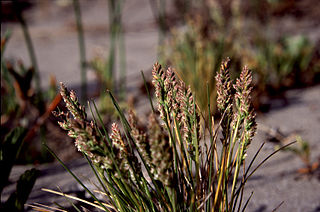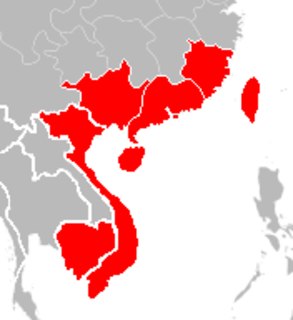
Dimocarpus longan, commonly known as the longan, is a tropical tree species that produces edible fruit. It is one of the better-known tropical members of the soapberry family Sapindaceae, to which the lychee and rambutan also belong. The fruit of the longan is similar to that of the lychee, but less aromatic in taste. It is native to tropical Asia and China.

Nephelium is a genus of about 25 species of flowering plants in the family Sapindaceae, native to southeastern Asia.

Dimocarpus is a genus of about 20 species of trees or shrubs known to science, constituting part of the flowering plant family Sapindaceae. They grow naturally in tropical south and Southeast Asia, Malesia, Papuasia and Australasia, including Sri Lanka, India, the Philippines, southern China, Taiwan, Burma, Cambodia, Vietnam, Malaysia, Indonesia, New Guinea, East Timor, far north-eastern Queensland Australia.

Psilogramma increta, the plain grey hawkmoth, is a moth of the family Sphingidae.
Albonectria rigidiuscula is a fungal plant pathogen. The anamorph of A. rigidiuscula the fungus Fusarium decemcellulare is associated with inflorescence wilt and vascular necrosis in fruit tree crops such as Mango, Longan and Rambutan. F. decemcellulare causes a disease known as cushion gall in Theobroma cacau and other tropical trees.
Dimocarpus australianus also known as Australian native lychee, is a species of trees, closely related to the longan, constituting part of the plant family Sapindaceae. They are endemic to Cape York Peninsula, Australia. The edible fruit tastes like lychee, sweeter than longan, and occasionally gets described as 'too sweet' in comparison by longan fanciers.
Dimocarpus yunnanensis is a species of tree native to China related to the longan. They are usually 10 feet (3.0 m) tall when fully grown. The drupes are small and inedible. They are sometimes grown in gardens as ornamental plants.
Tillandsia confinis is a species in the genus Tillandsia. This species is native to Venezuela, Bolivia Colombia, Peru, northern Brazil, and Ecuador.

Poa confinis is a species of grass known by the common names coastline bluegrass and beach bluegrass. It is native to the coastline of western North America from British Columbia to northern California, where it grows on beaches, dunes, and other coastal habitat.
Conopomorpha litchiella is a moth of the family Gracillariidae. It is known from Australia, China (Fujian), India, Malaysia (Selangor), Nepal, Taiwan and Thailand.
The litchi fruit borer or the litchi stem-end borer is a moth of the family Gracillariidae. It is present in China, India, Nepal, Taiwan, Thailand and Vietnam.

Oraesia emarginata is a species of moth of the family Erebidae first described by Johan Christian Fabricius in 1794. It is found in Australia, New Caledonia, Indonesia, New Guinea, Pakistan, the Philippines, India, Sri Lanka, Sulawesi, Taiwan, China, Japan, Korea and Nepal as well as Eritrea, Ethiopia, Kenya, Namibia, Nigeria, South Africa, Tanzania, the Gambia, Uganda, Oman and Yemen.

Comostola laesaria is a moth of the family Geometridae first described by Francis Walker in 1861. It is found in Sri Lanka, India, Indochina, southern China, Taiwan, Sundaland, northern Australia and the Bismarck Archipelago.

Eressa confinis is a moth of the family Erebidae. It was described by Francis Walker in 1854. It is found in India, Bhutan, Sri Lanka, Myanmar, Taiwan and China.
Homona eductana is a species of moth of the family Tortricidae. It is found in India, Thailand, Malaysia, Singapore and China.
Hypoponera confinis, is a species of ant of the subfamily Ponerinae, which can be found from Sri Lanka, and China.

Solidago confinis, commonly called southern goldenrod, is a North American species of flowering plants in the sunflower family. It is native to California, southern Nevada, and Baja California.

Thalassodes immissaria is a moth of the family Geometridae first described by Francis Walker in 1861. It is found in the Oriental tropics of China, India, Sri Lanka, Hong Kong, Japan, Borneo, Vietnam, Sumatra, Sulawesi and the Ryukyu Islands. The populations in Ryukyu are often classified as a subspecies - Thalassodes immissaria intaminataInoue, 1971.
Dimocarpus fumatus is an Asian tree species in the family Sapindaceae.

Longan witches broom-associated virus is a species of positive-sense single-stranded RNA virus that has not been assigned to a genus within the family Potyviridae. It is thought to be the cause of witch's broom in longan, a large tropical tree from southeastern Asia of economic value. Longan witches broom disease is a condition that was first described in 1941. The virus was found in symptomatic plants and absent in healthy plants, but not all of Koch's postulates have been fulfilled.










